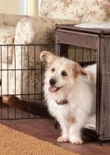
 Dog crate training doesn’t have to be an overwhelming or even frustrating task. When you use the right methods, you can successfully crate train your dog without using force or punishment.
Dog crate training doesn’t have to be an overwhelming or even frustrating task. When you use the right methods, you can successfully crate train your dog without using force or punishment.
The first step to crate train your dog is to create a positive association with his crate. This will help your dog to learn that his crate is a place of rest and comfort, not a place intended for punishment.
Conditioning Using Treats & A Clicker
Instead of throwing your dog into a crate to let him get used to his new environment, use a clicker with reward-based training to help your dog acclimate and make a positive association with his crate.
This is a truly smart way to approach dog crate training; you will lure the dog into the crate with delicious treats. Once your dog goes into the crate willingly to receive the treats, you can use the sound of a clicker to reinforce the action and encourage good behavior.
This is by far the most effective method in dog crate training to use to reinforce a positive association with a crate. Instead of feeling like you are locking your dog in a crate for hours at a time as a form of punishment when you leave the house, your dog will start to see dog crate training as a game.
When this method is used properly, your dog will love spending time in his crate – believe it or not. After this method has been used for successful dog crate training, you can leave the door of the crate open all day long so that your dog can enter as he pleases. You may find that your dog will enjoy resting and taking a nap inside of the crate because he feels comfortable, safe, and protected.
Once this happens, you will know that you have used dog crate training successfully! The entire point of a crate is to give your dog a safe, restricted area to spend time in whenever you leave the house. This will set clear boundaries for your dog so that he feels secure and is not anxious about doing something wrong and getting punished.
Session expired
Please log in again. The login page will open in a new tab. After logging in you can close it and return to this page.
If your dog has long hair or you live in a hot climate, a wire crate offers plenty of ventilation to keep your dog cool. The bars on wire crates should be spaced close enough to keep your dog’s head and paws from squeezing through.